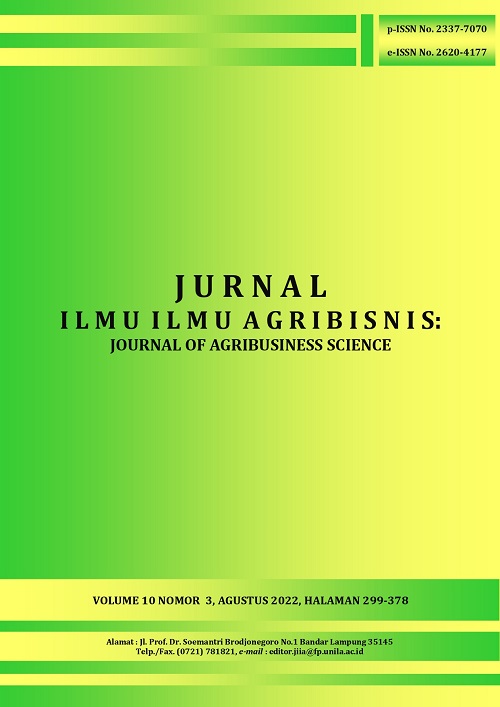PERILAKU IBU RUMAH TANGGA DALAM PEMBELIAN DAGING SAPI DI PASAR TRADISIONAL DI KOTA BANDAR LAMPUNG
DOI:
https://doi.org/10.23960/jiia.v10i3.6087 Abstract View: 291
Abstract View: 291
Abstract
This research aims to know the characteristics of consumers and the process of decision making, analyze the purchase pattern and the attitude of consumers forwards beef attribute at Bandar Lampung traditional markets. This research conducted by a survey method at Bandar Lampung traditional markets, namely Panjang market, Way Halim market, and Pasir Gintung market. Research data were collected in August - September 2019. The 36 respondents were selected by accidental sampling method. The results showed that respondents were housewives aged 25--35 years old, with the number of family members amounting to 4--5 people, household average income of IDR 4,602,778, and predominantly Javanese. The pattern of beef purchases by housewives is buying meat in traditional markets due to various options. The amount of beef purchased in the last month was 1.1--2 kg with the type of meat that is most purchased is sirloin. Scores of consumer attitudes towards the beef attribute using the Multiattribute model of Fishbein acquired attitude score of 108.35 or category quite well, the color attribute of 18.88, the fiber attribute of 18.28, and the value of the freshness attribute of 18.16, while the price attribute gets the lowest value of 17.41. The attitude of the consumers to the beef attribute is the beef must have a bright red, dense and fresh.
Key words: attitudes, beef, characteristics, purchases
Downloads
Downloads
Published
How to Cite
Issue
Section
License
Authors who publish with this journal agree to the following terms:
Authors retain copyright and grant the journal right of first publication with the work simultaneously licensed under a Creative Commons Attribution License that allows others to share the work with an acknowledgement of the work's authorship and initial publication in this journal.
Authors are able to enter into separate, additional contractual arrangements for the non-exclusive distribution of the journal's published version of the work (e.g., post it to an institutional repository or publish it in a book), with an acknowledgement of its initial publication in this journal.
Authors are permitted and encouraged to post their work online (e.g., in institutional repositories or on their website) prior to and during the submission process, as it can lead to productive exchanges, as well as earlier and greater citation of published work (See The Effect of Open Access).














